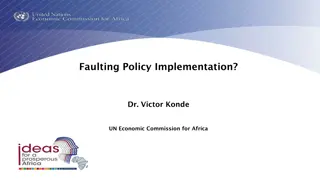A Human Rights-Based Approach to Law and Policy Making for Internally Displaced Persons
This comprehensive presentation covers the international legal standards, frameworks, and rights pertaining to the protection and assistance of internally displaced persons (IDPs). It emphasizes a human rights-based approach as the foundation for developing laws and policies, highlighting the importance of upholding IHRL, IHL, IDRL, and other key instruments. The Guiding Principles adopted by the UN Human Rights Commission in 1998 provide practical guidance for ensuring the rights of IDPs are respected throughout all phases of displacement, including the prohibition of arbitrary displacement.
Download Presentation

Please find below an Image/Link to download the presentation.
The content on the website is provided AS IS for your information and personal use only. It may not be sold, licensed, or shared on other websites without obtaining consent from the author.If you encounter any issues during the download, it is possible that the publisher has removed the file from their server.
You are allowed to download the files provided on this website for personal or commercial use, subject to the condition that they are used lawfully. All files are the property of their respective owners.
The content on the website is provided AS IS for your information and personal use only. It may not be sold, licensed, or shared on other websites without obtaining consent from the author.
E N D
Presentation Transcript
A human rights-based approach to law and policy-making 1
Objectives To illustrate the bodies of international law relevant to IDPs protection and assistance To determine the legal obligations towards IDPs that derive from international instruments To present a human rights-based approach as the basis for law and policy development To identify IDPs rights during all phases of displacement 2
International legal standards International legal framework for IDPs Human rights IHL IDRL IHRL International criminal law 3
International law IHRL IHL Applicable during conflict Applies to everyone at all times The Geneva Conventions and their additional protocols contain provisions to protect civilians Applicable to all displacement situations States can impose certain derogations in cases of emergency Imposes duties on states and other warring parties Core non-derogable rights 4
International law (II) ICL IDRL Genocide, crimes against humanity, war crimes - 1998 International Criminal Court (ICC) Statute Legal instruments to facilitate international assistance Hyogo framework for action (HFA) contains disaster risk reduction (DRR) measures to minimise exposure and risks Deportation and forcible transfer of civilians (articles seven and eight) IASC operational guidelines on human rights during disasters Responsibility for arbitrary displacement Early warning systems and DRR Arbitrary displacement punishable by law Reparation for damages 5
The Guiding Principles Adopted in 1998 by the UN human rights commission 30 principles restate international law All phases of displacement covered Provides a rights-based approach to IDPs protection and assistance Provides guidance to states and others Identifies relevant IHRL and IHL standards A practical tool 6
Prohibition of arbitrary displacement Guiding principle six: Right of all people to be protected against arbitrary displacement: Arbitrary displacement Respect Protect Fulfil Refrain Prohibit Prevent Examples of prohibited displacement 6.2 Legality Legitimate aim Necessity IHRL IHL 7
Prevention Guiding principle seven: State responsibility to prevent and avoid conditions leading to displacement Conflict: Disasters: Protection of minority rights, rule of law, participation, adequate standard of living There is no such thing as a natural disaster, only natural hazards. UN office for DRR Prevention of IHL violations that trigger displacement Disaster management, mitigation and preparedness Dialogue with all parties, outreach to security forces, training Early warning systems Fight against impunity Model act on disaster relief and initial recovery assistance, 2013 Criminalisation of arbitrary displacement 8
IDPs protection: Guiding principles 10 to 23 A. Civil and political rights related to people s lives, safety, physical wellbeing and family unity. B. Economic, social and cultural rights related to food, basic shelter, health and primary education D. Civil and political rights related to personal documentation, and freedom of movement, expression, opinion, religion and voting C. Economic, social and cultural rights related to housing, land and property (HLP), livelihoods, and secondary and higher education Source: UN secretary general s representative on IDPs human rights 9
Durable solutions: Guiding principles 28 to 30 and the IASC framework Achieved when IDPs no longer have specific needs linked to their displacement and can enjoy their human rights without discrimination on account of their displacement . Establish IDPs right to a free and informed choice between: Sustainable reintegration in place of origin Sustainable local integration Sustainable integration in another part of the country Affirm the state s responsibility to establish the conditions for IDPs to achieve durable solutions 10
Criteria for durable solutions Accessible mechanism for restoration of HLP Long-term safety and security Adequate standard of living Personal and other documentation Access to livelihoods and employment Family reunification Access to remedies and justice Participation in public affairs Goal three of Yemen s national policy on IDPs covers the creation of conditions enabling safe, voluntary and durable solutions to displacement . 11
Regional standards African Union Convention for the Protection and Assistance of Internally Displaced Persons in Africa (Kampala Convention) Pact on Security, Stability and Development in the Great Lakes Region (Great Lakes Pact) Protocol on IDPs protection and assistance Protocol on returnees property rights 12
Conclusions International legal standards are benchmarks for states action. IHRL, IHL, IDRL and ICL are relevant to IDPs protection and assistance. Adhering to international standards is a general state responsibility. A human rights-based approach should guide policy-making processes. 13























